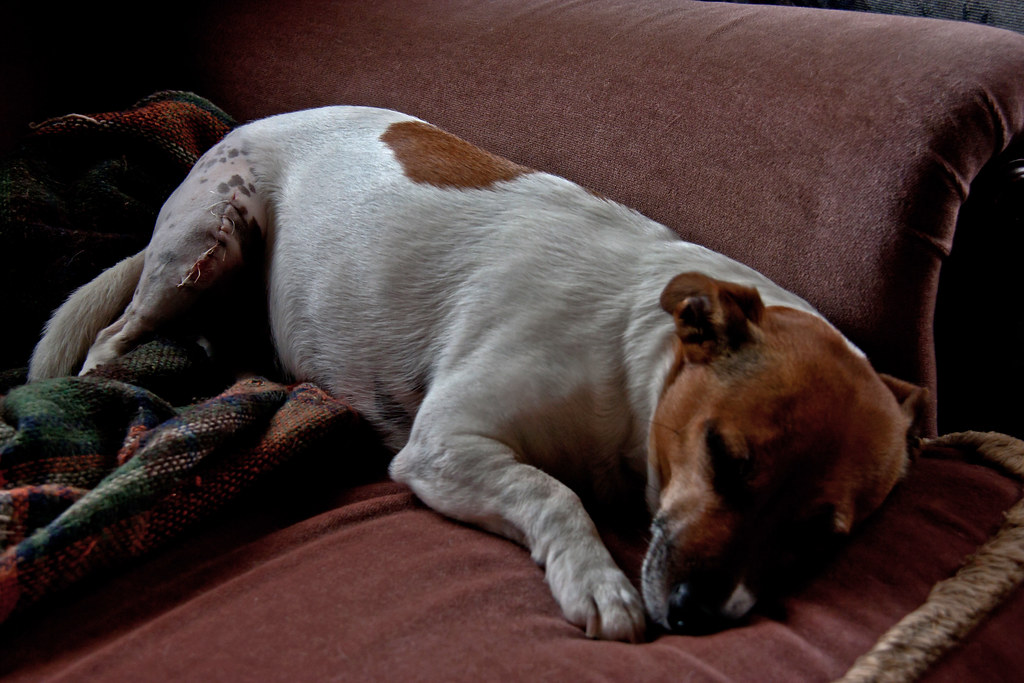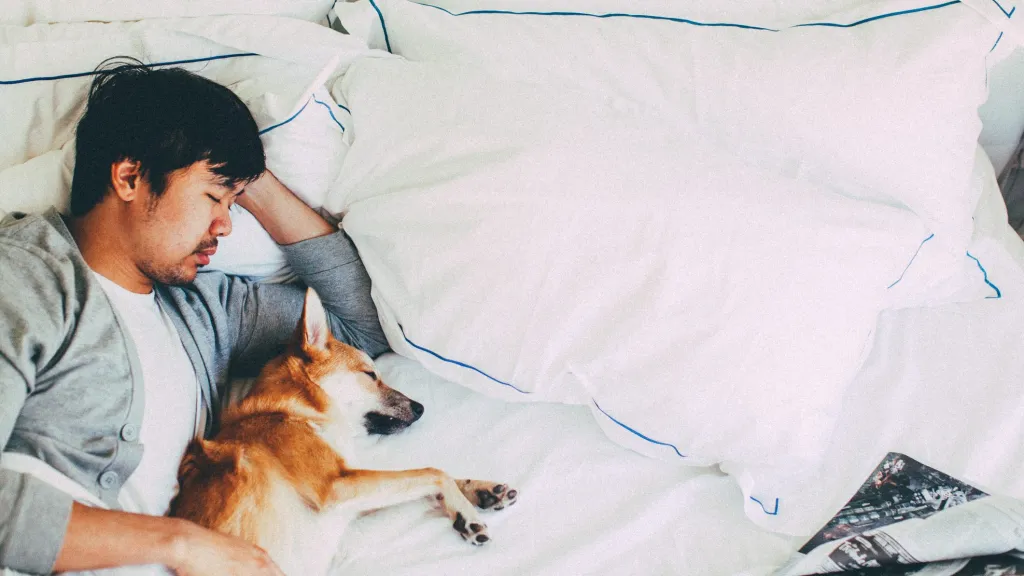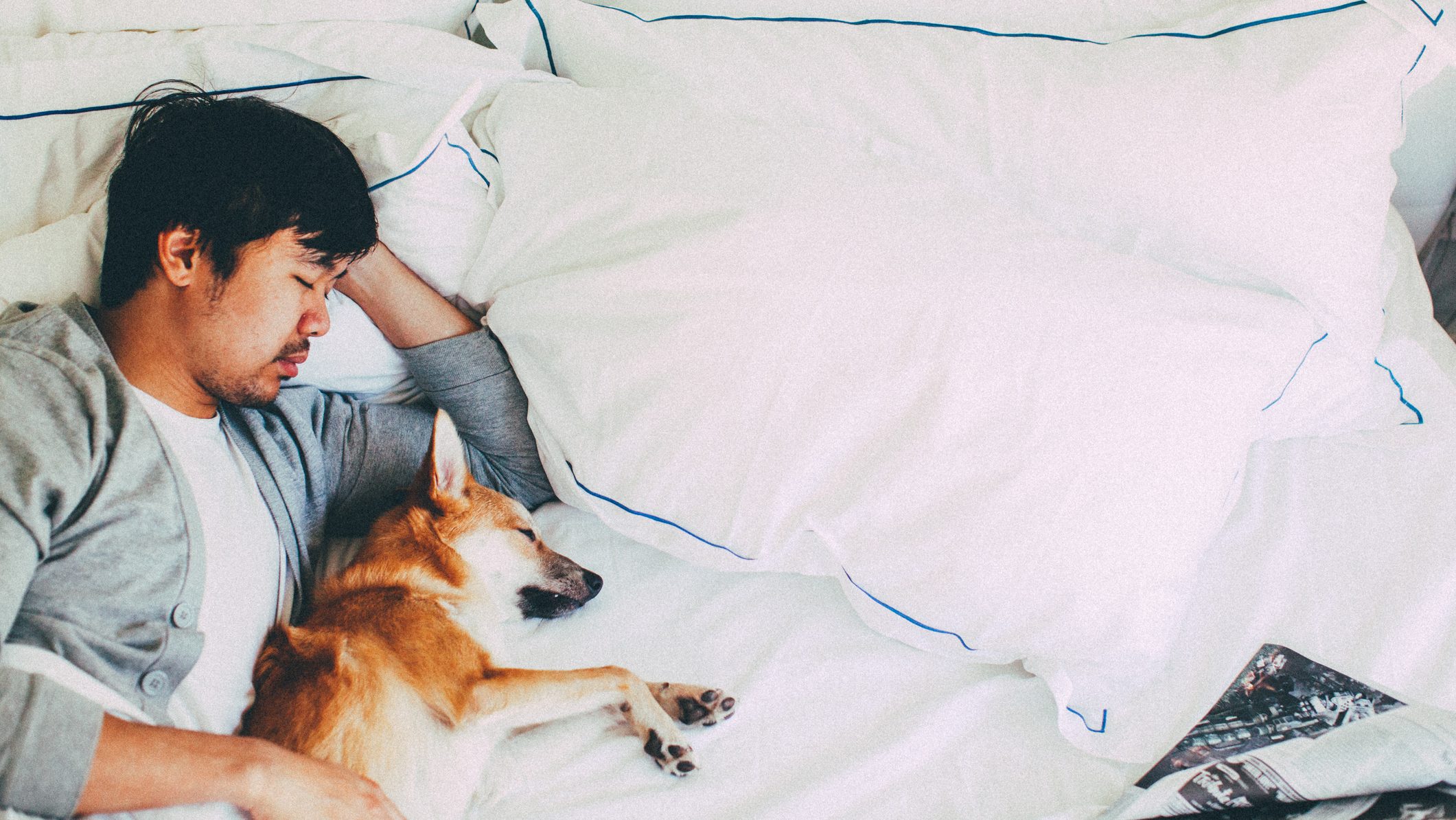Common dog sleeping positions
Your dog’s sleeping position can reveal a lot about their mood and health. It’s fascinating to observe the various ways dogs like to sleep and what these positions can tell us. Whether stretched out with limbs splayed or curled up in a cozy ball, each sleeping posture provides insight into a dog’s comfort, temperature regulation, and feelings of security.

(Photo Credit: Sean Savery Photography | Getty Images)
Below are some common sleeping positions and what they might mean:
- Supine position – When a dog lies on their back with their belly exposed, it indicates they feel safe and relaxed. This position also helps dogs cool down by exposing less fur to direct sunlight or a cool surface.
- On the side – Dogs sleeping on their side are generally comfortable and relaxed. This posture leaves their vital organs exposed, showing they feel safe. It also allows for greater freedom of movement during sleep, resulting in more twitching and limb movement.
- Curled up – Curling up in a ball conserves body heat and protects a dog’s vital organs. This position, also known as “nose-to-tail,” restricts movement during sleep, leading to less twitching. It’s common in cooler weather or just a preferred position for some dogs.
- Sprawled out on the tummy – Often referred to as the “Superman” position, this allows dogs to quickly get up and be ready for action. You’ll frequently see puppies or high-energy dogs in this posture, ready to play at a moment’s notice.
- Back-to-back or snuggled up – When dogs sleep back-to-back or cuddled up with other pets or their owners, it indicates a desire for closeness and bonding. This position shows comfort, affection, and trust with their sleeping companions.
By observing your dog’s preferred sleeping positions, you can gain valuable insight into their well-being and emotional state. Understanding these habits helps foster a closer bond and ensures your furry friend feels safe and loved.
Understanding sleeping behaviors
Once your dog is napping, you may get some clues about the quality of their sleep from their behavior. Sleep is important for healing and repairing the body, and REM sleep, which is the deepest stage of sleep, is the most restorative. Pay attention to these signs and behaviors to make sure your dog is getting the best sleep possible.
Circling and Digging
It’s normal behavior for dogs to circle their sleeping area or even dig a bit before lying down for sleep. This is behavior that comes from dogs’ wolf ancestors who would often trample down grass, leaves, or snow to get comfortable. They might also dig a hole that would help keep them warm in winter or cool in summer. Though dogs tend to circle a few times before lying down, doing it too much or having trouble settling in might be a sign of pain, arthritis, or a neurological issue. Consult a vet if you notice excessive circling.
Light Dozing
A dog might doze off during the day if they’re bored or just getting a rest. This is not a very restful sleep, and your dog may just be waiting for something more interesting to come along. Watch your pup’s ears and see if they perk up at any movement or unusual noise. This probably means that your dog is still fairly alert and looking for something worth getting up for. Maybe it’s time to do something fun like go for a walk or play fetch.
Twitching, Wagging, or Soft Barks
Dogs tend to move a bit during REM sleep when they’re most restful. They could very well be acting out their dreams, but they are getting a nice, deep sleep. Twitching, tail wagging, leg kicks, and occasional barks or grunts are common. This is a good time to let sleeping dogs lie. This stage of sleep is very restorative and good for their health. Movement during sleep is actually more frequent in puppies and senior dogs for unknown reasons. Sometimes your dog will move from spot to spot while sleeping. A less common reason for twitching during sleep is if a dog is cold. The twitches are the body’s way of warming up. If your dog is cold, get a blanket or move them to a warmer sleeping place.
Signs of Distress
Like humans, dogs can have nightmares. If your dog seems particularly agitated during sleep with more movement, barks, or whimpers than usual, you can try gently calming your pup down. Call their name softly and stroke their back or side. Use soothing tones. Your pup may wake up or may just simply relax and continue on with a more pleasant dream after you’ve comforted them. If you notice your dog frequently seems agitated during sleep, you may want to schedule a vet visit to be on the safe side.
Seizure
When twitching gets excessive, it could be a sign of a seizure that requires immediate medical attention. Try calling your dog’s name and waking them up if you suspect their movements are abnormal. If they wake up, it may have just been an intense dream. If they don’t respond to your calls, continue to shake, or feel stiff, get medical help right away. You should pay attention to your dog’s usual sleeping habits so you know the difference and can tell when something is out of the ordinary.
Recognizing signs of distress
When dogs appear restless or stressed during sleep, it could indicate underlying issues that require attention. Unlike light dozing or simple dream movements like twitching, distress signs are often more intense and frequent.
Have you noticed your dog whimpering, growling, or displaying significant movement like running in place? These behaviors might seem amusing or explainable through dreaming, but persistent or extreme occurrences may suggest deeper health or emotional concerns.
If this kind of behavior becomes a pattern, it could be worth examining for possible causes such as:
- Nightmares: Just like people, dogs can have bad dreams that disrupt their sleep. Gently speaking to your dog or petting them can help soothe them back into a more peaceful slumber.
- Anxiety: Dogs can experience stress and anxiety which manifest during sleep. Identifying stressors and creating a calming bedtime routine can help alleviate this issue.
- Medical Issues: Sometimes, sleep disturbances can be linked to underlying medical conditions. Joint pain, digestive discomfort, or even neurological problems might be the root cause. A visit to the vet can help pinpoint and treat these issues.
| Signs of Distress During Sleep | Possible Causes |
| Excessive Whimpering/Whining | Nightmares, Anxiety, Pain |
| Frequent Growling or Snarling | Fear, Aggression, Emotional Disturbance |
| Intense Running Movements | Night Terrors, Excess Energy, Neurological Issues |
| Heavy Panting | Stress, Overheating, Illness |
Paying attention to these signs not only ensures your dog gets quality rest but also alerts you to potential health concerns that may need addressing. Help your canine companion feel more secure and relaxed during sleep by observing and understanding these behaviors. Have you ever wondered if your dog’s sleep habits mirror their wild ancestors’ survival instincts? Watch carefully and think about what these deeper connections might reveal!
Next time your dog displays unusual sleep behavior, consider what might be causing it. Providing a comfortable, secure, and familiar sleeping environment can work wonders. And, if needed, consult with a professional to ensure your furry friend is as healthy and happy as possible.

Why dogs sleep close to their owners
There are a few key reasons why dogs commonly like to sleep pressed up against or in contact with their human owners:
- Comfort & Security – Sleeping right against you brings feelings of warmth, comfort, and security for your dog. Your presence next to them makes them feel protected and less anxious.
- Bonding – Being physically close while sleeping fosters bonding, attachment, and trust between a dog and their human caretaker. This skin-to-skin contact releases oxytocin, also known as the “love hormone.”
- Your Scent – Your unique scent is soothing and familiar to your dog, while also letting them make sure you are close by. Sleeping against you allows them to inhale your scent and always know where you are.
- Warmth – Your body radiates heat that keeps your dog nice and cozy while they sleep curled up against you. Sharing body heat is appealing for warmth-loving canine companions.
- Pack Mentality – Since dogs are pack animals, sleeping huddled together is natural. Being right against you fulfills their instinct to sleep as part of their pack for comfort and protection.
So, in many cases, your dog sleeps pressed up on or very close beside you because it makes them feel safe, secure, loved, and comforted – reflecting their natural tendencies as domesticated animals evolved to view their owners as family!

How much sleep dogs need
Dogs sleep a lot more than people do. On average, dogs need about 12 to 14 hours of sleep a day. Big dogs tend to take longer naps than smaller dogs. Puppies can sleep about 12 to 20 hours a day, usually waking up for an hour after every few hours of sleep. Take notice of your dog’s normal sleeping habits. If you notice a change in how long your dog sleeps, it could mean a lot of things, from a dietary change to a thyroid problem. If your dog is spending too much time napping, it could be time for a vet visit.
Older dogs and larger breeds often need more sleep due to the physical stress their bodies go through daily. In contrast, younger dogs and smaller breeds might be more energetic and require less napping time. It’s important to allow your dog to get the right amount of rest to ensure they remain healthy and happy.
Knowing how much sleep your dog typically needs can help you watch for changes that might indicate a health concern. For more information about dog sleeping habits, you can read more here: What Your Dog’s Sleeping Position Means.
